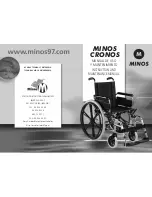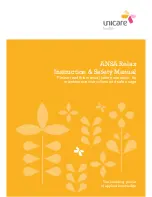
5900A Powerchair Owner’s Manual DCR1236
magicmobility.com.au
16
Be aware that it may be difficult for traffic to see you
when seated in your powerchair. Wait until your path is
clear of traffic, make eye contact with drivers and then
proceed with caution.
3.16 Driving at night
Lighting is designed to improve visibility
while driving the chair in low-light or at night. It’s
also intended to make the chair more visible to others.
Be aware that your lights are not always visible to drivers
or pedestrians, especially if viewing you from the sides
of the chair.
3.17 Driving while elevated
If you have power elevating seating, it’s important to
heed ALL warnings outlined below. The higher you
elevate the less stable the powerchair becomes. This will
help you understand how to reduce the risk of tipping
over, and how to identify environmental conditions that
could affect your safety when driving while elevated
(also see Section 4.12).
•
Never exceed the weight limit (Section 3.5)
•
The lift mode should only be used on flat, level surfaces
•
Elevating or driving in lift mode should never be
attempted on uneven terrain such as gravel, grass,
bumpy surfaces, soft surfaces, uneven footpaths
or slopes.
3.18 Thermal roll-back
Your powerchair has a thermal roll-back circuit. This
protects the controller from damage due to overheating.
In extreme conditions (such as repetitive hill climbing)
the circuit will decrease power to your motors. This
allows the powerchair to operate at a reduced speed.
When the controller cools, normal speeds are resumed.
3.19 Terrain
Your powerchair is great on firm, even surfaces such
as concrete and asphalt. However, depending on the
choice of drive wheel, more challenging terrains such
as muddy fields, hard sand, gravel, mulch, long grass,
kerbs and gutters can all be tackled. Heed all warnings
in this manual and be sure to take someone with you
while exploring.
3.20 Obstacles, steps and kerbs
Driving over obstacles or kerbs can cause
your powerchair to tip over resulting in serious
injury. If you have any doubt that you can safely cross a
kerb or obstacle, always ask for help. Be aware of your
skills and personal limitations. Develop new skills with
the help of an assistant.
Keep your eyes moving when you drive; scan the area
ahead to look for obstacles.
Figure 3.1 - Approaching an obstacle
Given the off-road capability of your powerchair, it may
be capable of climbing and descending a variety of
obstacles, however this can vary greatly depending on
the set-up of the powerchair, weight distribution and
user’s ability.
If your powerchair is fitted with power seating functions,
it’s a good idea to tilt back or elevate your legrest a few
degrees when ascending or descending kerbs or steps
to protect your legrest from impacts. Excessive use of
power functions in this situation may cause a tip over
resulting in injury.
•
Proceed with extreme caution when driving near
raised surfaces, unprotected ledges, drop-offs, kerbs,
porches, stairs, escalators, lifts etc. Always approach
an obstacle so both front wheels touch that obstacle
together (Figure 3.1). Never attempt to climb a kerb or
obstacle at an angle
•
Don’t attempt to ascend any kerb near a drain cover,
uneven surfaces or gravel covering
•
Avoid travelling backwards down any step, kerb or
other obstacle
•
Use the ramp or kerb cut out if there is one
•
Do not attempt to climb obstacles when the
seat is elevated.
















































